Bike messenger
This TED talk by Stefan Sagmeister kinda pushed me to do something I’ve always wanted to try. Granted, I didn’t do anything that helped anybody, or anything design-related. Just something completely different from what I’ve been doing the 9 years prior. After my studies in computer science, I naturally got a job as a software engineer. After a couple of unsatisfying projects, the final blow was given when the mobile app I had been working on for 1.5 years was completely dismissed by management and never released. So I quit my first “real” job. I had gotten that engineering position without ever looking for a job, nor having to write any motivation letter. My application for a bike messenger position at Krick was therefore probably a bit clumsy and naive. But it was 100% honest and I didn’t try to embellish anything. Here it is:
Depuis que j’ai vu des épisodes de Streetwise sur la TSR le samedi matin quand j’étais gamin, j’ai été fasciné par les coursiers à vélo. Avant l’avènement d’Internet, les images de coursiers étaient rares, et je n’en ai en réalité pas revus jusqu’après avoir déménagé à Lausanne pour mes études. Autant dire qu’avec la topographie vallonée, les coursiers lausannois étaient de sacrés spécimen. A chaque fois que j’en voyais un, je me disais qu’il faudrait un jour que j’essaie aussi.
Ce jour est arrivé. Pendant les études, je n’avais pas le temps de me consacrer à autre chose. Puis je me suis fait embaucher directement après avoir décroché mon diplôme. Après plus de 8 ans chez le même employeur, j’ai envie plus que jamais de changer d’air; un désir d’une activité plus physique, à l’extérieur, avec une équipe soudée et au contact des gens, qui contraste avec des journées au bureau à faire du développement web pour des clients totalement anonymisés par les strates administratives de l’entreprise. Je suis venu habiter à Genève en 2004 pour travailler dans l’informatique, mais également pour ma passion, le BMX. Je pratique toujours plusieurs fois par mois, si ce n’est plus prudemment qu’il y a quelques années. J’ai également été actif dans une association genevoise qui collaborait avec la ville de Genève pour mettre en avant le BMX. J’ai aussi rendu service à une connaissance qui oeuvrait pour la promotion des déplacements à vélo en ville, chose qui me tient à coeur. En effet, je ne possède à ce jour toujours pas de voiture, je fais quasi exclusivement tous mes déplacements en singlespeed ou à pied, peu importe la météo. Je pense qu’au bout de presque 9 ans, je me repère très bien dans l’agglomération, malgré une méconnaissance notoire des noms de rues. Lors de mes nombreux voyages avec le BMX, j’ai toujours adoré me faufiler dans le trafic des villes et découvrir de nouveaux environnements urbains.
Même si mes activités sportives ne sont pas trop typées endurance, je pense posséder les qualités physiques requises au quotidien du coursier à vélo. Les autres tâches comme l’administratif ne sont pas un problème non plus, au contraire. Je suis une personne très ordonnée et organisée.
It really is all true. I was fascinated from the first time I saw an episode of Streetwise. I also remember seeing a documentary once on TV about messengers in NYC, crazy guys wearing hockey helmets, riding brakeless, holding on to cars etc. That must have been in the early 90s as well. Anyway. I either never had time to give it a try myself (studies, army duty), felt somehow pressured by society to have a regular 9-5 software engineering job, or simply didn’t think I was physically able to handle bike messenging. So one day I thought “fuck it” and gave it a try. And it’s been one of the best times of my life.
I would now like to recount some facts and stories about how I perceived this one year as a bike messenger.
The daily routine
At my engineering job, I didn’t have fixed office hours but still had some kind of daily routine. At Krick, the hours were fixed: 08:00 till 18:00. I would get up at 06:45 and have breakfast – which I didn’t before – because I would be pedaling for the next 4 hours. During the first couple of weeks, while eating I would rehearse all the streets where I’d picked something up or made a delivery to. I kept a list of addresses and I would just mentally place them on a map. I’m pretty sure none of my colleagues did this at their beginnings, but it helped me getting to know my way around the city. I would then leave home at 07:30 and get into HQ at around 07:45.
At the beginning, for every order that came in over the talkie-walkie, I had to stop riding, take out my notepad and write it down completely. An order obviously consists of a pickup and a delivery address, but it can also have a door code, a specific sender or recipient – hence, a person inside the company –, a price breakdown – base + extra distance + extra weight + express –, be a country-wide delivery via swissconnect etc. When there was a lot going on, I even rode with the notepad in one hand, I didn’t even bother putting it back into my hip bag. The weeks pass and the orders tend to be the same or very similar to one another. You start to know the street names, and you don’t need to write anything down anymore. Unless you suddenly end up with more than – say – 3 simultaneous deliveries. Sometimes the runs get so similar that you operate on autopilot and end up at the wrong place. That happened to me twice, but it was OK because they were inner-city deliveries. Also, at the beginning, you have to be careful with street names that sound similar. For example, on my first week, I almost rode up to Rue de Bandol instead of Rue De-Candolle. PHK – Philipp Krick, the owner of Krick, and usually our dispatcher – hates repeating himself, so I tended to never ask twice if I wasn’t sure. Which in my opinion is besides the point of having talkie-walkies, but that’s the way it is.
At Krick, there are different kind of shifts:
- morning: 08:00–12:30 or 09:00–13:00
- afternoon: 13:00–18:00 or 13:30–18:00 (which is odd, but I had it a couple of times)
- all-day: 08:00–18:00, 09:00–18:00 or 09:00–19:00. Krick officially closes at 18:00 but there might sometimes be pickups ordered right before closing, which can make the delivery happen until 19:00. On one occasion, I actually ended up in Founex around 20:00 on a Friday evening.
The best shift in my opinion is the 09:00–13:00 one. Most companies don’t get started until 09:00 and you tend to get some deliveries right before noon that need to be done asap.
At first, I didn’t request any specific schedule from PHK. I let him plan my shifts in the morning, afternoon or all-day. I let him add more and more shifts per week until I felt I’ve reached my maximum. I couldn’t do more than 8 shifts a week. As I wanted to be able to still ride some BMX after work or on weekends, I decided that 6 shifts would be perfect. I asked PHK to schedule me preferably on mornings. This way I would be forced to get up in the morning, but have free afternoons and evenings.
One thing that is worth mentioning is that bike messengers are underpaid. The whole system basically only works because the people doing that job are either students or really passionate bike-crazy guys – and a few girls of course. At Krick, your salary is a percentage of your turnover. The unwritten rules are that you start off with 38%, then 43% after 3 months and finally 48% after 6 months or even 1 year. I was lucky to get to 43% after only 3 weeks and to 48% after 4 months. You would think that your turnover is related to your speed and efficiency to navigate the city, but that’s not really the case. The dispatcher tends to distribute the deliveries evenly among the messengers, and rightfully so. If you happen to be at the right place at the right time and there is no reason to dispatch to someone else, you can get lucky and have 5–6 simultaneous deliveries. The price of a delivery depends on:
- a base price of 16 CHF for inner-city, delivered in the hour following the order
- 5 CHF extra for every additional kilometer
- 2 CHF extra for every additional kilogram
- 16 CHF extra if the delivery needs to be done in 30 minutes instead of 1 hour
- swissconnect deliveries are a world of their own
One hour for an inner-city delivery might seem a lot, but you have to take into account that the messenger might have something else going on already and might not be close to the pickup point. It’s up to the dispatcher to know where his guys are located and assign a delivery to the right messenger.
You can see on this graph of my day-after-day hourly salary that there are quite a few fluctuations that depend on a lot of parameters that one can’t really influence. Overall though, I got a little better over time. It doesn’t seem to matter if you work in the morning, in the afternoon only or the whole day. As I have only worked 1 year, I cannot tell if there are any seasonal fluctuations. There tends to be a bit less work during Summer and a bit more at the end of the year, but even that doesn’t seem to have an impact on the salary curve. At the beginning, PHK rounds the salary up to 20 CHF per hour (grey dots on the graph). Afterwards, I got any variations from 15 CHF to 43 CHF per hour. From the graph, I’m not sure it’s possible to say if there is a weekday where the chances you earn more are higher. Maybe Thursday or Friday?
The next graph shows that there is also no direct relation between the number of deliveries and the salary. Look for example at the Wednesday salaries compared to the Wednesday deliveries. There are a couple of peaks in one graph that aren’t reflected in the other graph.
Whereas the two previous graphs show hourly salary and number of deliveries, the next one displays the total amount per day. Grey bars represent missing data. There are two ways for a client to pay for a delivery: cash or account. The way it works at Krick is that you keep the whole cash amount, not 38% or 43% or 48% of it. It makes everything easier for PHK, but for us messengers this means that you actually get a big chunk of your monthly salary every day in cash. This in turn means that you need a bit of self-discipline not to spend it too fast and keep some for your bills. I actually ended up putting it on my bank account in order to keep track of my expenses like I used to do for years.
Enough writing about money. I think I’ve made the point clear that this job is way underpaid. But that’s how our society works.
The gear
During the job interview, PHK likes to have a look at your bike. I’m pretty sure he always finds something that isn’t right. In my case, he asked me if I like to tinker. Apparently in his eyes my Schwinn had a fragile look or something. I told him that I’ve been riding it like that for years and never had any problems. It turns out that – of course – riding your bike to work and riding your bike for work makes quite a difference. Your gear takes its toll. During the first days, I lost a screw on one of the crank arms and I had to hit it with my foot every couple of hundreds meters to keep it in. Not very efficient to say the least. Then I blew a bottom bracket bearing. Another time, the axle on my rear hub broke in two. It took me a while to figure out what was going on because that never happened to me. I had that rear hub for that last 15 years! I figured I ought to get a spare set of wheels, just in case[1]. And then, 2 months later, I bought a new bike. Now I had my old Schwinn for rainy days, and a new Focale for the summer. All of these technical mishaps occurred without ever telling the dispatcher. That’s crisis management there.
I always ride with a singlespeed, not fixed. I played a bit with various gear ratios. On the Schwinn, I started with a 48x16 ratio, on 26" wheels. When I broke the bearing on my cranks I used the ones from my DH bike for a while, with a shity ratio of 36x14. Then, instead of going back to 48x16, I used a 44x16, a bit on the light side, but more aesthetically pleasing because I wouldn’t need a chain tensioner. On my Focale, the ratio is 46x16, but on 700mm wheels. Then there’s the consumables. You have a lots of flats. And usually they follow Murphy’s law. During my worst shift, I had 5 flats. On a Friday morning in June. I would say that this is the worst part of the job. Worst than cold rainy days. Worst of all? Having several flats on a cold rainy day. You can’t feel your frozen fingers, you have to change your tire, of course you happen to cut yourself – which happens kinda fast with cold dry skin – and now you have wet, bloody and greasy hands. Usually the clients show some understanding. One even took out his little pharmacy box and patched me up. On rainy days also, the brake pads wear off really fast. When it rained non-stop, I ran through a pair of pads in one day. Maybe they were crap, but I tried a couple of different ones and couldn’t notice any difference. Surprisingly, I never tore a brake cable or broke a chain. I was however prepared for both, with a spare piece of chain, a chain tool, pliers and a brake cable in my bag.
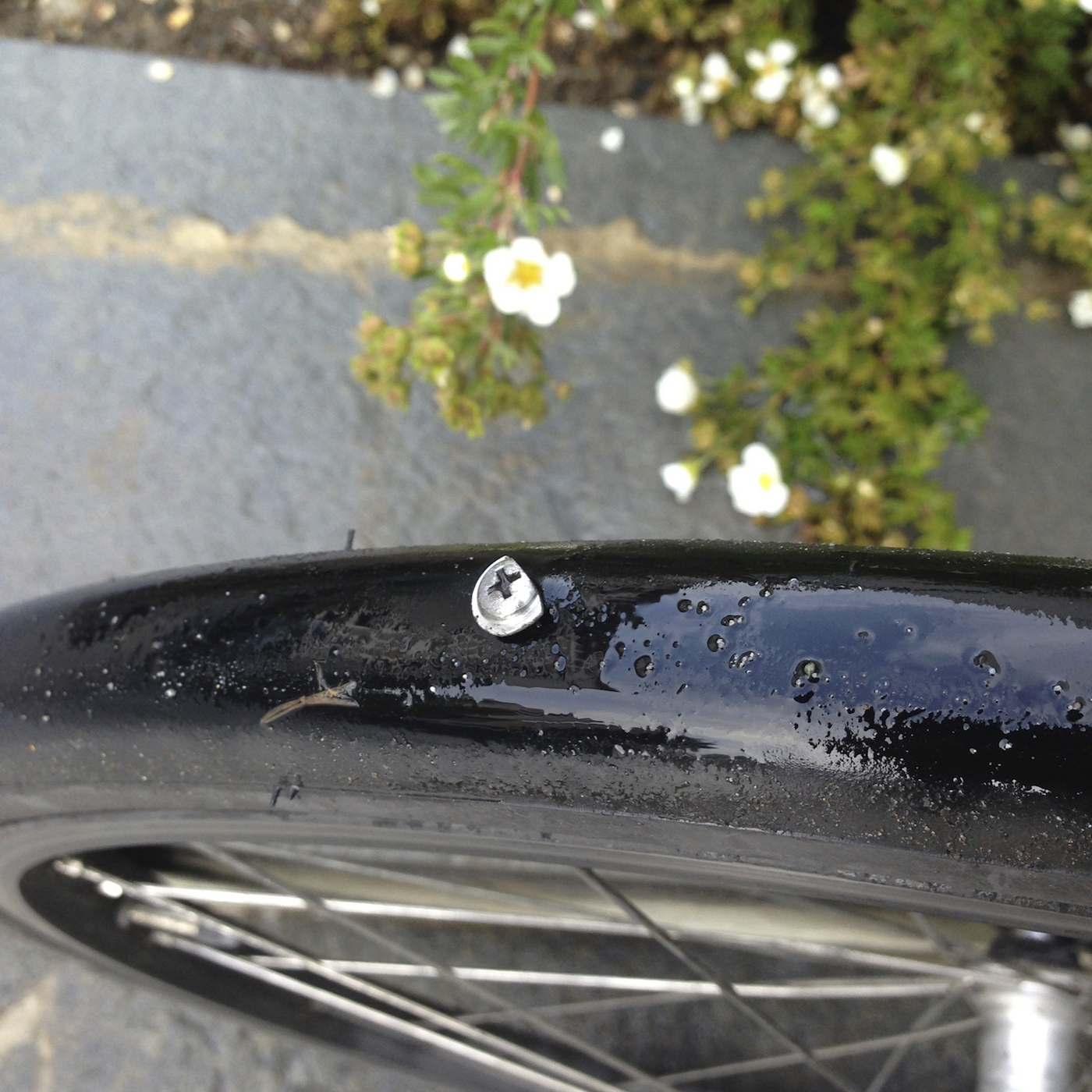
Besides your bike, there’s plenty of other gear. Let me go through the list from top to bottom. I already had a – bad looking – helmet. I didn’t want to wear my glasses because it’s a bit cumbersome with the sweat, the rain or the moisture due to the temperature difference between out- and inside. So I made an appointment to check my eyesight again and then order 2 packs of 90 1-day lenses. It turned out however that I didn’t even use a quarter of them. Whereas it was important at the beginning that I could read the street signs, once I knew my way around I didn’t need to read anything anymore. Then I bought a couple of cycling pants, short and long, black because that’s what PHK wants, a bunch of long-sleeved shirts and some gloves for the winter. I rarely wore the gloves because it’s not practical: I couldn’t answer my iPhone and I seem to be unable to write with gloves on. Then there’s the messenger specific stuff. For the time you’re employed, Krick provides 1 long-sleeved and 1 short-sleeved jersey, a messenger bag and a talkie-walkie. The latter three are not personal items, which is incredibly unhygienical regarding the messenger bag. Imagine sharing your sweat with 10 other guys! Besides envelopes, parcels, blood samples, flowers etc. you’re delivering, you should have in your messenger bag a couple of swissconnect bags and a first-aid kit. For your bike. And since I had 2 bikes, I needed 2 sets of tools – one bike has quick-release wheels, the other doesn’t; one has 26" wheels, the other doesn’t etc. I had to be careful when I chose the bike for my shifts, that I also took the right set of tools with me. The burden of choices ;) Finally, you might also need spare clothes or additional reserve layers depending on the weather. You cannot count on being able to return to HQ to change during your shift.



I’m still not sold on the talkie-walkie. It has some good and bad parts. Compared to dispatching by phone there’s a higher immediacy. The dispatcher and all the messenger communicate on the same channel, everybody hears everything, and that makes it all easier in case of uncertainties or stress. The reach of talkie-walkies is limited though. What makes it even worse is that PHK gets pissed if you don’t know that in a particular area, the radio is not working, and you basically just produce static when talking. He also gets batshit crazy when 2 people accidentally radio in at the exact same time, which happens statistically surprisingly often – or maybe I’m missing something about how these gadgets work. In the end, the dispatching is done over talkie-walkie and phone, which I find a bit besides the whole point of having talkie-walkies. Another annoying point with those talkie-walkies is if the streets get noisy – usually when it rains, or for example when close to a construction site – you can’t hear anything. An ear piece would solve this, but the talkie-walkies seemed to have a proprietary connector.
Yoann gave me his old hip bag. It suited my needs well. Have I kept on doing that job for more than year, would I have made a custom one, a bit more compact. I mostly used my iPhone to look up street addresses, but I kept 2 paper maps as backup in my hip bag. It also contained the notepad I mentioned earlier and the receipts, a.k.a. “justi”, in a nifty little plastic case that for one prevented them from getting wet and also made it easier to hand them to the clients to sign if there was no desk or countertop. Finally, I had a spare set of lock keys in there, and the money of the deliveries that were paid cash.
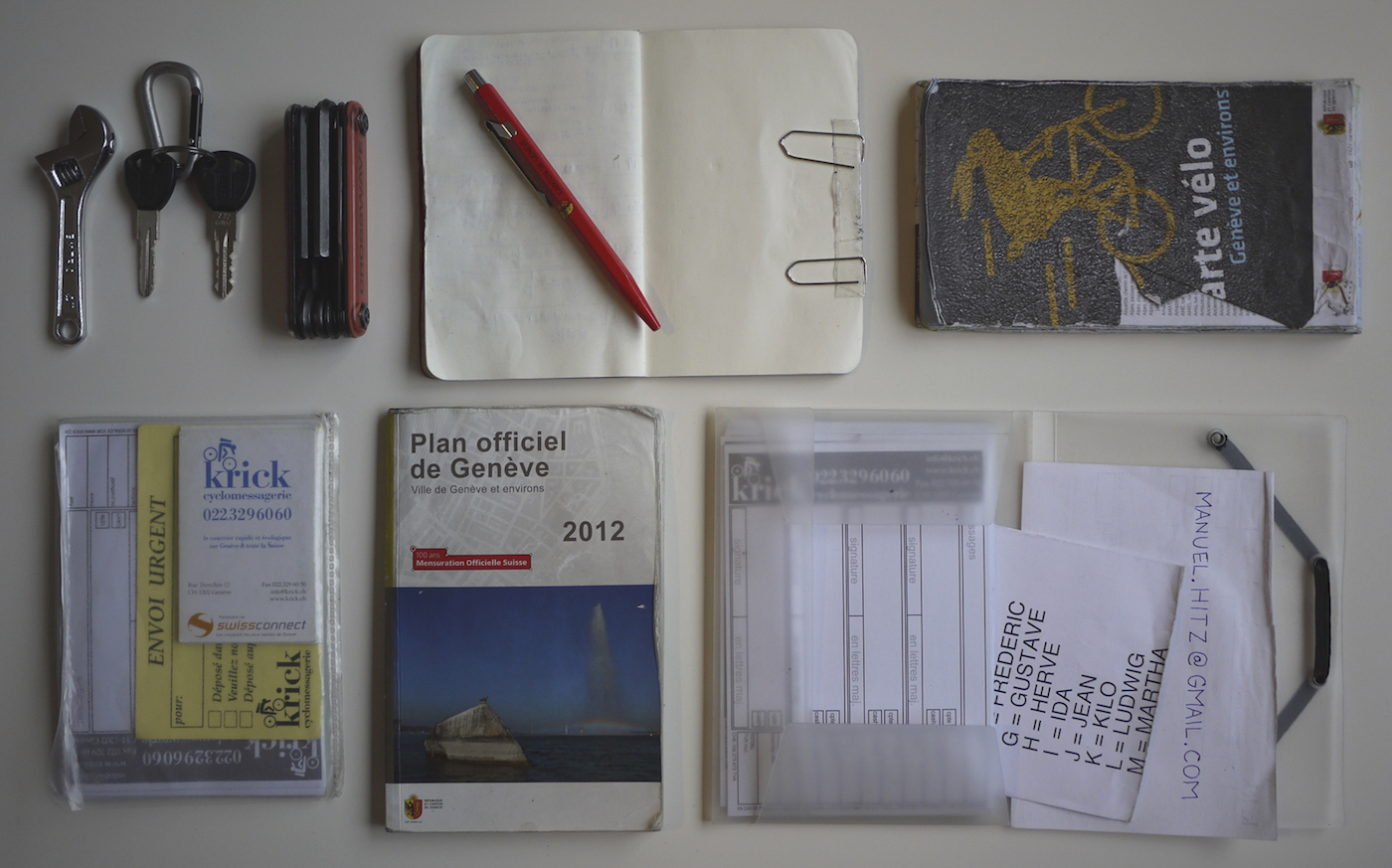
For the first 6 months I rode with flat pedals. Then I figured I should try to ride clipless. I had never tried it before, and must admit that it scared me a bit. It turned out to be a very good decision. Right now, I’m still riding clipped on my Focale and even on my new NS Bikes mountain bike.
One of the few if not the only thing I learned in the army[2] is that if you want to be efficient in certain situations, you must have a routine. A methodical way of doing things that doesn’t require you to think. Everything is done in the same order, and you never forget anything. I found that this was suiting for quite some things in bike messenging. Maybe you think that my reasoning is a bit extreme, but for me it worked. I rarely forgot stuff. Here are some of my routines:
- the order of stuff in my hip bag was always the same: notebook with the pen clipped to it, the receipts, the map. This ensured that I could very quickly pull anything out, without looking, while riding one-handed in traffic
- the hip bag was worn on the right side, because I’m right handed and also because the front brake – the only brake on my Focale – is on the left
- the talkie-walkie was operated with the right hand, for the same reasons
- same also for my lock key that was clipped with a snap link on the left shoulder strap of the messenger bag
- I locked my bike every single time. Even when arriving at HQ because this way, I wouldn’t forget my lock key on the messenger bag when leaving for home. This happened once, and this rule is the consequence.
- “justi” were always kept in the order of my route. This way if I had a short memory loss – what house number was it again? – I could just quickly pull out my transparent case and read the address
- at the end of the shift, when arriving at HQ, I would: lock my bike, (take a leak), empty my bag (for others to use), return the talkie-walkie, return the p.o. box key (if any)
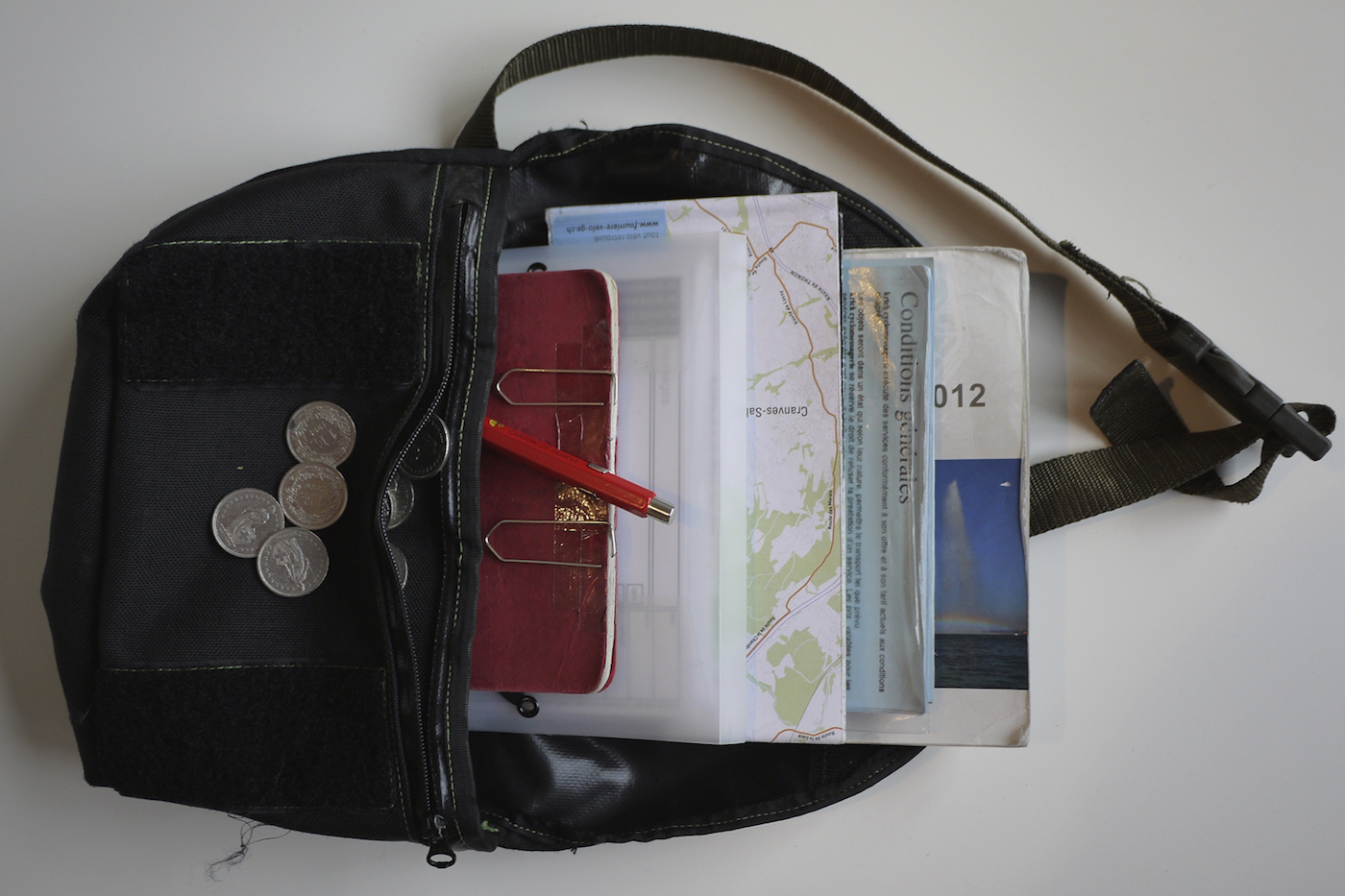
On my iPhone, I used a couple of apps and bookmarks.
- Google Maps, obviously, but only for address lookup, not route calculations
- I found forecast.io to have the best combination of accurate weather forecast and nice design. I compared a bunch of apps and services, and this one clearly stood out. In a job like this one, you really need a good 1 day forecast.
- public WC locations
- I discovered a handy amateur website listing all swiss train compositions. This was sometimes useful to know where the cargo wagon was located for swissconnect deliveries
- arrival/departure panel in the SBB app (also available online)
I tried to rely on them as little as possible. Out of pride, but also because you really want your phone battery to last the whole day, or at the very least through one shift. That’s also a reason why I never used Strava to track my shifts, even if I really would have liked to. In retrospect, I should have bought an external battery pack and trace the routes by GPS.
The clients
I briefly mentioned the kind of things that a bike messenger delivers. Basically anything, as long as you think it’s humanly possible. Krick also has a cargo bike for extra large payloads. We mostly deliver A4 and A3 envelopes. We don’t and are not supposed to know what they contain, but looking at who requests the delivery and who the recipient is, you get an idea what it might be. It’s usually documents that either need to be signed or stuff that should leave no digital trail. Judging by the companies on Krick’s clients list, it’s pretty safe to assume that there is quite some shady stuff going down. There’s for example Glencore Mercuria which is globally involved in the trade of natural resources, Gunvor which supposedly has funding by Putin, Genève’s freeport which is involved in arts trade, and pretty much everyone living in Cologny who has ties with finance, oil, real estate etc.
Genève, because of all the international organizations, has a lot of embassies where people need to get visas and other kinds of documents from. There are also companies active on an international level that need documents to be legalized. Messengers take these to various places such as the Chambre de commerce, Registre du commerce, Chambre Arabo-Suisse de Commerce et d’Industrie, Service des légalistations etc. Genève’s official website states this:
Le service des légalisations s’occupe de légaliser les documents devant être reconnus, soit directement à l’étranger, soit via les représentations officielles établies en Suisse.
Les documents, tels que apostilles, légalisations simples, légalisations de traducteurs-jurés et copies certifiées conformes, peuvent être légalisés par le service.
Tout document étranger doit au préalable être légalisé par un notaire de Genève pour obtenir la légalisation officielle de Genève.
I don’t know why I never looked that up while I was still working, because what I did back then makes a bit more sense now.
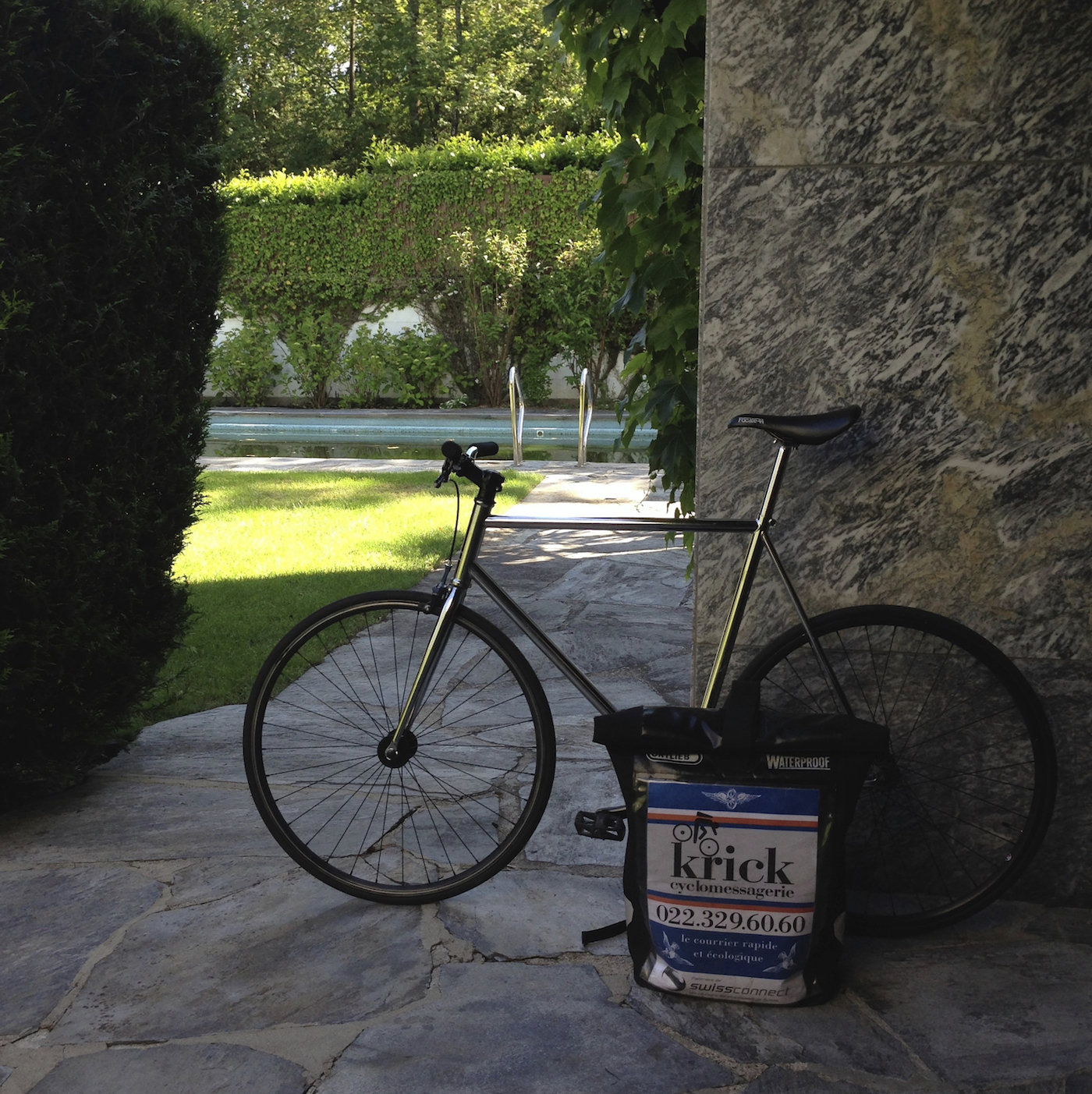
Genève also has a sizable “haute horlogerie” scene: Piaget, Rolex, Richemont, Vacheron etc. and a whole lot of small players – small in size, probably not in revenue – that provide pieces of watches in various precious metals or stones. Bike messengers are used to deliver some of these. This I find pretty cool actually. Some design studios also use our service, maybe because besides being faster of course, we handle weird formats with less hassle than the postal service.

Then there’s the more mundane tasks of emptying P.O. boxes in the morning because the secretary of the client won’t walk her lazy ass to the local post office[3]. Easy money for us messengers. We also regularly have to collect bloodwork or urine samples from doctors offices and deliver them to the labs, and vice-versa. Or dental molds from the dentists to the prostheses maker.

The interactions at all those clients are quite limited. Of course we don’t have the time, but also most of the people seem to look down on us obviously dumb, poor and uneducated bike messengers. There is the usual chitchat about the weather, about how many kilometers we ride on a day etc. When it’s raining, people pity us. When it’s sunny, they envy us. And you hear the same remarks the whole day. People. What could you expect. I naively and stupidly thought that I might meet some nice girls, but it turned out that the setting wasn’t suitable for new encounters. Tried it, didn’t work.

I had my share of fuckups. PHK doesn’t explain much about how the messenging gig works. The first time I had to make a legalization, I was a bit confused. But I didn’t fuck up. The first time I did fuck up was a legalization for a Japanese tobacco company – I’ll let you guess which one. I had to take their document to a notary but tell them that Krick will pay for the thing – PHK had to make up for another mistake or something… see I still don’t know what went down there! – and the lady didn’t understand what I told her. Probably also because I too didn’t know what I was saying. So the delivery ends up being charged to the tobacco guys, and the shit hit the fan. It was really nothing dramatic, but it was just blown out of proportion for whatever reason. A couple of other times I had clients not giving enough money to legalize a document and then accusing me of stealing. Yeah right.

The city
By the time I applied for the job, I had been living in Genève for 9 years. I was confident that I knew my way around the city very well. The only problem was that I had no clue about street names, mostly because I was never in a situation where I needed to know them. Like I mentioned before, I was a bit afraid that this would be a problem. It wasn’t. And it’s not like PHK expects you to know them when you start. It’s probably a lot harder to be a messenger in old European cities than in an American one with a grid numbering system. The only system we have, and I don’t know if it’s special to Genève, is that the house numbers get larger the further away you get from the lake or the Rhône. On very long streets, this knowledge makes you save precious minutes.
At the beginning, I hated to get long deliveries leaving the city to Meyrin, Plan-les-Ouates, Versoix. I wanted to do this job because I liked the thrill of riding in traffic, not because I wanted to do something that was close to road biking. After a while, you realize that these long-distance runs are nice too. You get out of reach of the radio signal, so it’s quieter. You get to relax a bit – while still pedaling hard of course. If during the same shift, fate wants you to ride to that same client in Meyrin twice, you start to realize how small the city is. One other weird thing that happens is that you actually end up knowing every bump and hole in the roads of the most traveled routes.

That much pedaling makes you pee. A lot. I thought that a bookmark to the city’s public restrooms would be handy. It turns out though that most of them are either closed, broken, or need to be paid for. So you start to plan your routes with this in mind. I know nobody cares, but it’s still fun to make a list of the restrooms I probably used most:
- Place de St-Gervais
- the business center at Avenue Cardinal-Mermillod 36
- Rond-point de Rive
- Place du Bourg-de-Four
- the ICC
I occasionally also could do a small pit stop at home. I even once did a bike swap because I had a flat right next to my apartment. Unannounced to the dispatcher, of course. One time, I had a cop coming towards me after I had peed into the Rhône. He took my ID and said that I would be fined. I only laughed and said that I had no choice with the current situation of public restrooms. In pure cop-logic he argued that I could have gone 500m farther downstream pee in the forest, which would have been OK. I haven’t received the fine yet.
I doubt this last point will interest anybody. Genève was about to celebrate its 200 years anniversary of being part of Switzerland. For the occasion, they created a bunch of online resources, like this alphabetical index of streets and who they’re named after or this repository of old maps of the city. I like it because it gives some context to some oddly named streets like Rue du Conseil-Général or Boulevard Emile-Jacques-Dalcroze. Also I love maps. And History is always interesting, in the sense of “How the hell did we get to how everything is how it is?”.
The weather
One thing I really don’t miss is getting up in the morning and having to check out the hourly weather forecast for the day to decide which clothes to put on, how many layers, reserve clothes, which bike to take etc. Most of the time the weather is no problem. You’re doing an effort, so you’re usually warm enough. If it’s raining in the summer, you dry off. If it’s really hot, you just drink a lot – and pee, see last section. The only real issue is cold and wet. You just stay cold and wet. For 8 hours in the worst case. It’s especially though on the feet. Maybe there are some magical remedies, but I couldn’t find any, and neither did the others it seemed.

2013 in Genève saw a rainy Spring, a below average Summer, an above average Fall and basically no Winter. I was a bit disappointed, I really wanted to ride at least one shift on snow, to experience the traffic chaos from the bike messenger’s point of view.
I didn’t think of writing down the weather after each shift. Instead, I used the forecast.io API which allows to query for past weather. Since I used forecast.io while working and it seemed to be pretty accurate, I guess that the data for the graph is mostly correct too. The dots represent temperature with the dashed white lines being 10ºC increments from 0 to 30. The vertical bars are the average weather during the shift – not the full day! – with the following meaning: clear day, partly cloudy or fog or wind, cloudy and rain. The forecast.io API doesn’t return the amount of rainfall, so there is no way of knowing if “cloudy”, “partly cloudy” and “wind” were also partly rainy or not. I would say “cloudy” most likely has some rainy bits, and so does “partly cloudy” because I specifically remember Spring being very rainy. That would be the 2nd third of the graph. Rain basically means it was pouring the whole time.
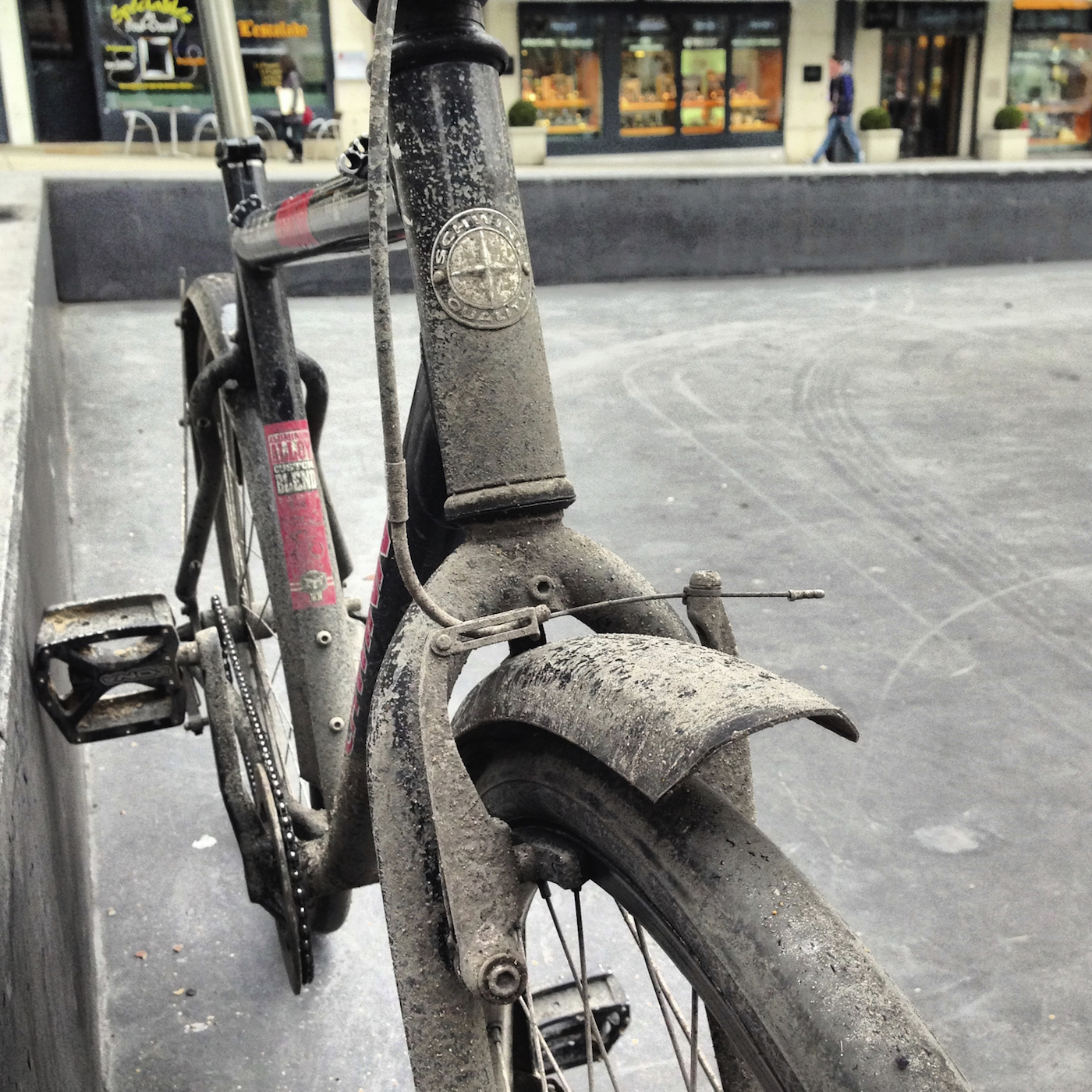
The family
You’ll hear and read this everywhere: bike messengers are a big family. It may sound cheesy, but there’s something to it. Maybe it’s because they’re a bunch of really passionate people being paid like shit for a tough job. I don’t know. But I definitely felt this. There’s a huge sense of camaraderie. At Krick especially having a boss as grumpy as PHK also unites. Things like the Krick Alphabet™[4] and some of his expressions like “sur ta côté droite”, “passe à la cyclo” etc. we will always remember.
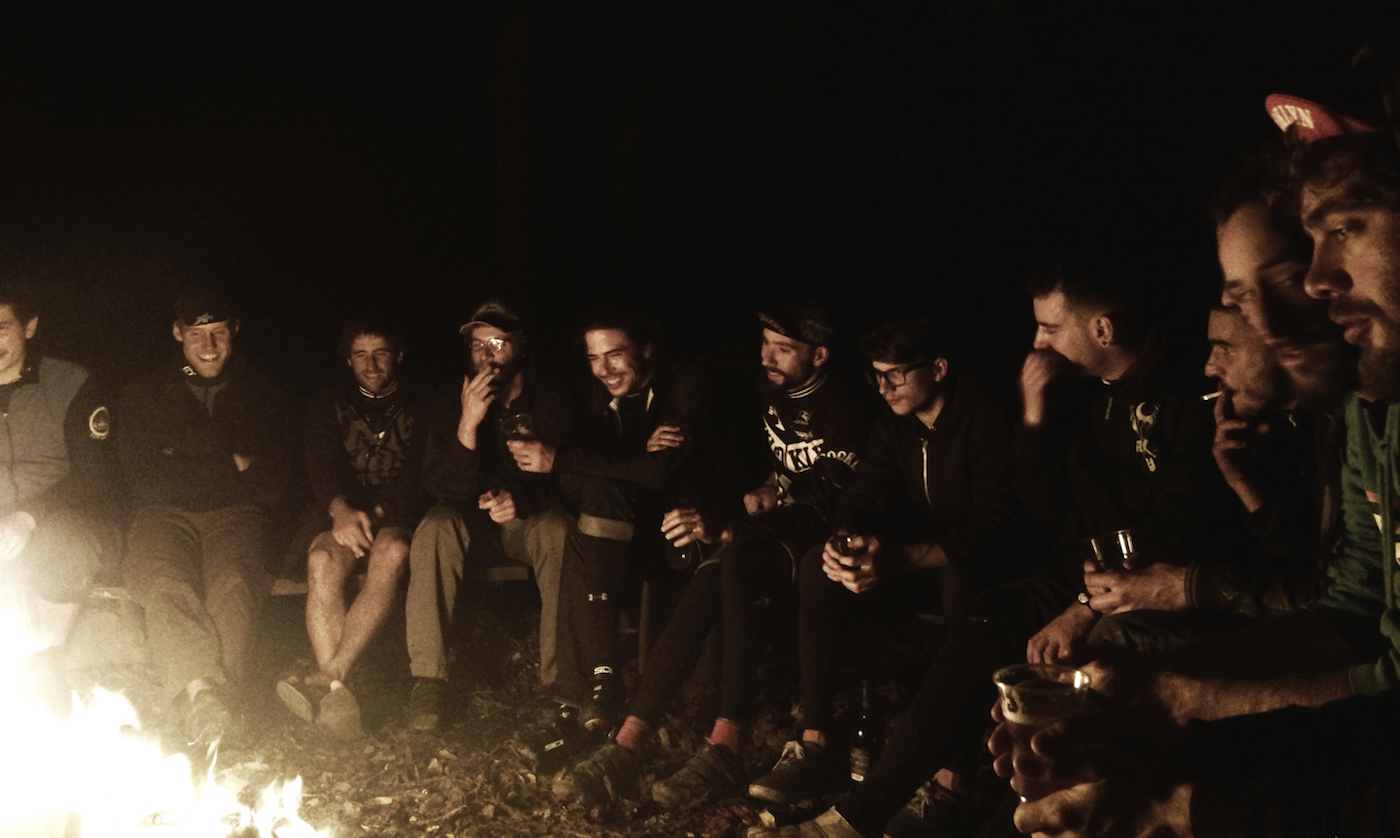
I remember PHK during my job interview saying that it was very important to eat healthy, because after all, bike messenging is sports. The first days I did try to be careful, but then realized that everybody else didn’t care. Quite the contrary, actually. You do so much exercise, that you can eat pretty much anything you want. Surprisingly a lot of my buddies smoke too. I would say inhaling car exhaust all day long should do enough harm to your lungs, no need to add anything else. There’s also a lot of beer involved after hours. My Dad, after watching Dead Fucking Last – which is a parody, granted – was kind of surprised his son would hang out with people like these. Haha WTF Dad.
It was a freaking awesome coincidence that the 2013 cycle messenger world cup (CMWC) would take place in Lausanne. It was a blast. True to my stupid self, I didn’t take part in any of the partying, but the competition was fun. To be clear, I didn’t compete, I was at one of the checkpoints with Yoann.

Another part of messenger culture are alleycats. Even before working as a bike messenger, I wanted to participate in one. But as usual, I chickened out every time. When I moved to Zürich in May 2014, I took part in the Cats The Rabbit alleycat where I got my first tattoo. Some people get tattooed when drunk, I get tattooed while alleycating.
Like for everything nowadays, you can find a whole bunch of movies on the web about bike messenging. Here’s for example one about Bill, a 52 years old doing bike-powered pizza delivery. He passed away recently. Here’s a video about an alleycat at the 2014 CMWC in Mexico. There is also this documentary about bike messengers at Vélocité in Lausanne. The same company also got featured in this article. I guess they’re a bit better at marketing than Krick.
Epilogue
I mention my bike-messenging gig a lot, and that’s for a reason: I loved it. It’s probably the second best thing I did in my life, after Building Virtual Worlds. Right now, my dream would be to work in web development 3 days a week and do bike messenging for 2 days. But that’s probably not possible. Unless I do free-lancing, which I’m really not sure to have the guts for.
2013 was also meant to be a sabbatical year, and I had quite some time at my disposal. Sadly I did absolutely nothing with it. I learned that you must have a plan before entering your sabbatical. Else nothing will happen.
sun rims, supposedly for touring, laced onto Shimano XT hubs. A bit on the heavy side, but lasting ↩︎
the army is mandatory in Switzerland. ↩︎
but then drive to the gym in the evening ↩︎
instead of using the standard radio alphabet, PHK came up with a list of first names which is pretty ridiculous for French-speaking people: Anna Bertha Cesar Daniel Emil Frederic Gustave Herve Ida Jean Kilo Ludwig Martha Nathan Otto Pierre Quentin Rodolphe Susanne Theodore Ursula Victor Walter Xavier Yvonne Zorro ↩︎